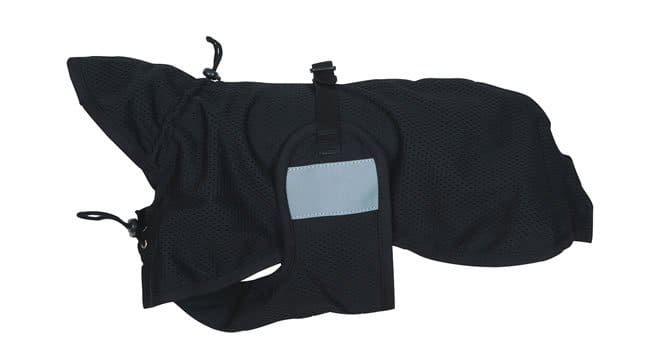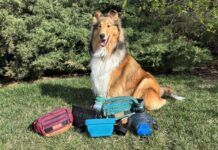
Pulled muscles and joint inflammation are as much a part of your dog’s life as your own, and they increase with age and activity. The fact is, no matter which way you turn it, strains happen. Imagine how great it would be if there was a magic garment that could soothe those strains and restore your dog to fitness. Well, you don’t have to imagine it: There is such a garment.
For initial injuries and acute pain, a veterinary diagnosis is a necessity. Your dog may need an anti-inflammatory drug to rapidly get the pain and inflammation under control. For chronic stiffness due to geriatric arthritis, a therapeutic daily dose of glucosamine to help lubricate those joints may make a difference. It may even slow the onset of joint degeneration, making supplementing sooner rather than later a smart move. Other complementary therapies for chronic issues include laser therapy (see “Hire the Lasers,” WDJ August 2013) and acupuncture (“Needle Your Dog,” November 2013). That’s because, for chronic pain issues, keeping your dog on a nonsteroidal anti-inflammatory drug (NSAID) isn’t optimal.
Many veterinarians will also suggest investing in a Back On Track coat, which sport-horse and performance-dog owners have long used for muscle strain from strenuous athletic activity, arthritis and muscle warm-up. These coats are so popular that if you attend a cool-weather, early-morning dog agility trial, you may think basic black is trendy in dog clothing.
In reality, the Back On Track products are established remedies for chronic inflammation and muscle health. Based on researched and documented Chinese medicine practices, these products use ceramic’s heat-reflective properties to increase circulation. The ceramic particles are infused into blanket material, which is warmed by the dog’s body heat. That heat then radiates back into the body.
This form of infrared heat radiation is proven to increase circulation, which naturally reduces inflammation, enhances healing, and relieves muscle tension.
Skeptical? Don’t be! A study from 2002 in Alternative Medicine Review looked at the ceramic-impregnated gloves for Raynaud’s syndrome in humans. People with Raynaud’s suffer from tightening of blood vessels, resulting in decreased circulation, usually in their fingers; it worsens in cold weather and can be painful. The study’s conclusions noted “significant improvement” in pain, temperature, grip, and dexterity, showing the ceramic increased circulation.
It’s actually the inside of the Back On Track blanket that contains the ceramic powder. The outer material is your choice: either a water-resistant breathable polyester or a lightweight, breathable mesh. The mesh is popular as it comfortably drapes over your dog and can be used in warmer weather and for more active dogs. Both blankets are machine washable, as the powder cannot be washed out (no dryers, though). We’ve seen dog coats in use for more than seven years.
Personal Experience with Dog Agility Problems
Draco is my 9-year-old Papillon and my first agility dog. We’ve been competing seven years and only need two qualifying scores to finish his last AKC Masters title, which is pretty good for a “first” dog. A couple of years ago, I noticed Draco was slowing down and less enthusiastic. He seemed excited at the start line, but slowed by the end of the course. In the second run of the day, he would start fast but slow down as he progressed through the course – and would even sometimes avoid obstacles.
I had my veterinarian examine him. She observed that, overall, his muscles felt tight. She mentioned that at his age we may be dealing with early arthritis, too. She said I could use pain medication to help him, but also suggested I spend more time warming him up and get a Back On Track coat first to see if it helped. I also decided to drop him to a lower jump height.
Huge improvement! Draco is back to running fast – sometimes too fast for me to control! When I get the coat out he puts his head right through the neck hole, as if he knows the coat makes him feel better. Once again, he is excited to be doing agility! In fact, last summer, I couldn’t hold him still at the start line!
Back and shoulder injuries are the most prevalent problems in agility dogs, and A-frames account for most injuries. Reluctance to tackle the A-frame is a pretty sure sign of a back problem, especially in a little dog.
When Raven, my younger Papillon, started to avoid obstacles, I had him examined, too. My vet readily detected the tight muscles in Raven’s back and showed me how to palpate them and recognize when they’re tight. I had no idea he was in so much pain, since he always gamely tried to do the courses. We used anti-inflammatory drugs to get Raven’s acute pain under control and I invested in a second Back On Track coat.

The difference in the tightness of his back muscles after wearing his coat was nothing short of amazing. I give him pain medication only for acute injuries. Although I decided to retire him from agility, as I didn’t want to risk further injury, I still have to watch him for back pain. However, with the Back On Track coat, I reach for the pain medication only for an acute episode – such as when he decided to race a visiting puppy all around our dog arena.
Using The Back on Track Blanket
Dogs do vary in their response to the blanket, and some take longer to achieve a noticeable effect than others. Nearly every dog owner reports at least a softening of tense muscles and less overall stiffness. You should gradually introduce the blanket, increasing from a couple of hours per day for several days up to overnight use. In addition, as counterintuitive as it seems, best results are found if you set up an on/off schedule for the product’s use, such as three weeks of therapy and one week off, or use it only when you notice increased stiffness or need to ensure proper warm up of your dog’s muscles for physical activity.
The blankets are available in an incredible number of sizes from toy to XXL, retailing from $79 to $109, depending on size. As is the case with any covering you place on your dog, you need to keep the ambient temperature and sun in mind when your dog is wearing the coat.
Take-Away Points
Back On Track products are no substitute for warm-up and cool-down periods or conditioning your dog for his level of work. And acute injuries can still occur and require your vet’s help. But for most chronic problems and overall muscle health, ceramic therapy is a valid choice, offering comfort to your arthritic friend and keeping your canine athlete at his peak. It’s important to know what issue your dog is battling before you invest, as Back On Track products are a bit pricey and most certainly not cure-alls. They do support muscle health and reduce pain and inflammation in the dog’s body.
Ceramic therapy’s use for chronic arthritis, circulation problems, and inflammatory muscle and bone issues is well documented. The company’s website (backontrackproducts.com) has convincing clinical studies, including images showing before/after inflammation in horses. We found several studies ourselves, including research published in February 2012 that concluded the biological effects of ceramic materials have “the potential therapeutic effects . . . may contribute to relieving inflammatory arthritis and maintaining bone health.” (You can read it for yourself at ncbi.nlm.nih.gov/pubmed/22242954.)
The company’s head office is in Sweden, and it manufactures these products for horses, dogs, and humans. The factories are in China, but the company states that an independent lab hired by the company measures each batch of ceramic textile to ensure its level of reflected heat.
Cynthia Foley is an experienced dog agility competitor. Also a lifelong horsewoman, she served as editor of Horse Journal from its inception in 1994 to 2014.






